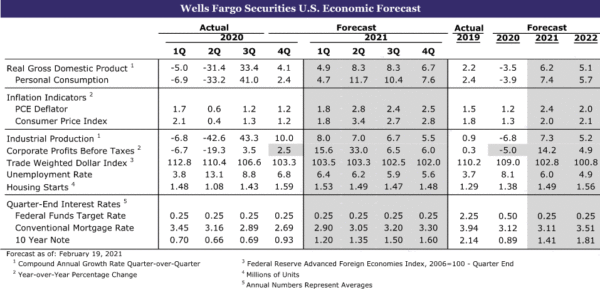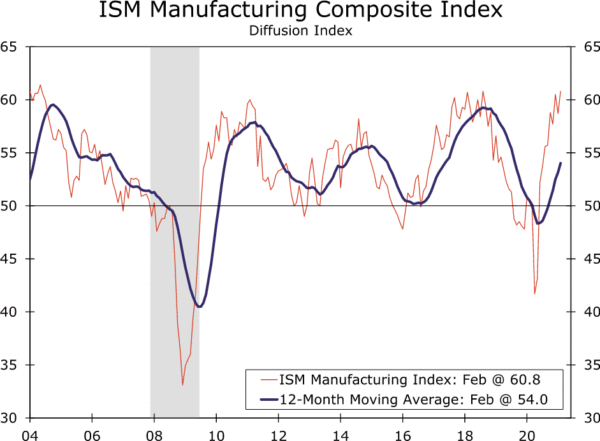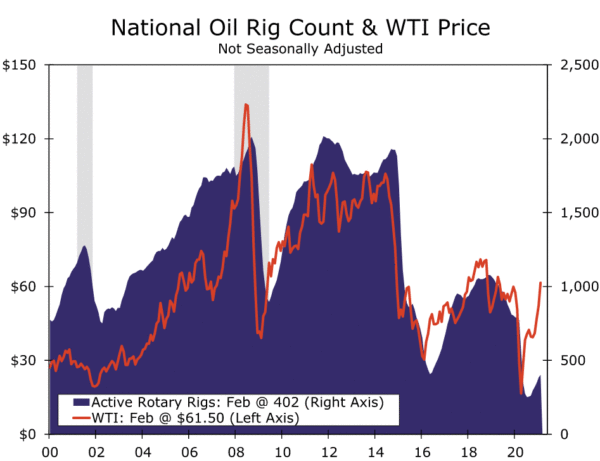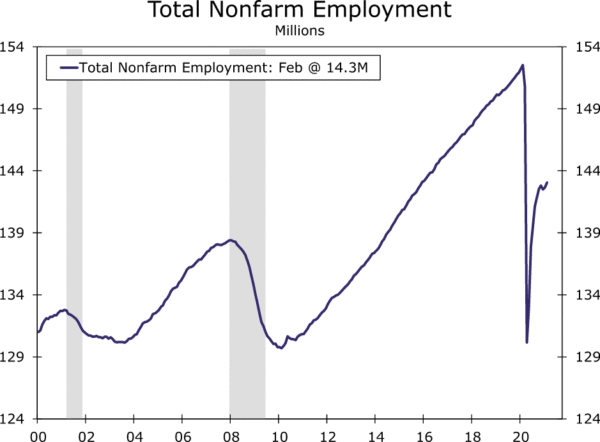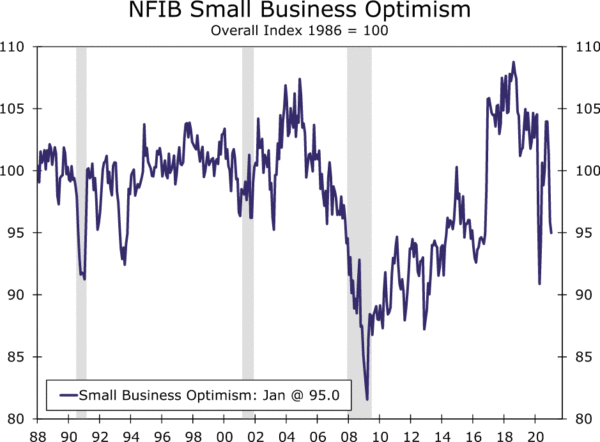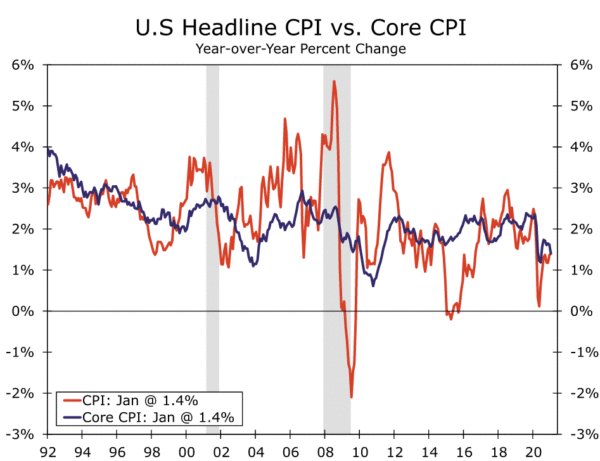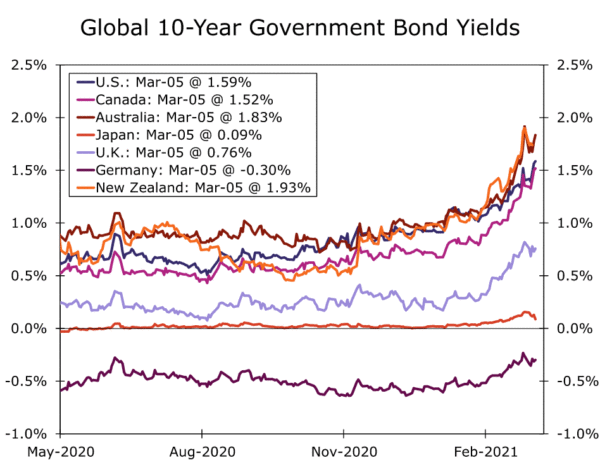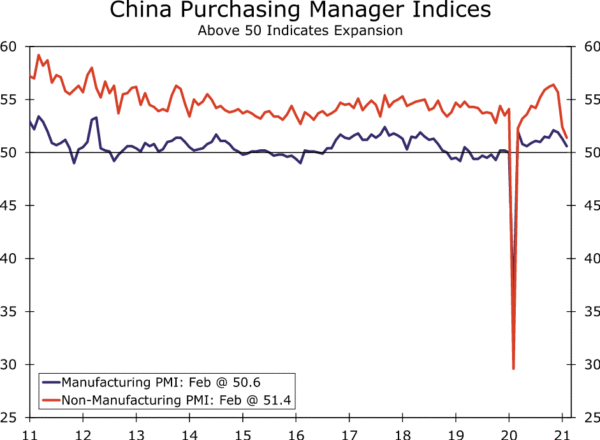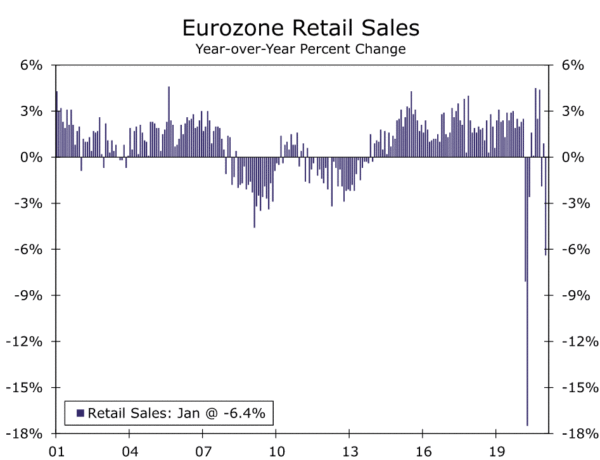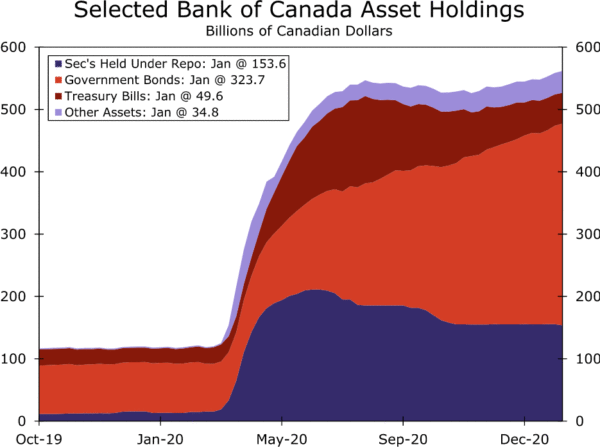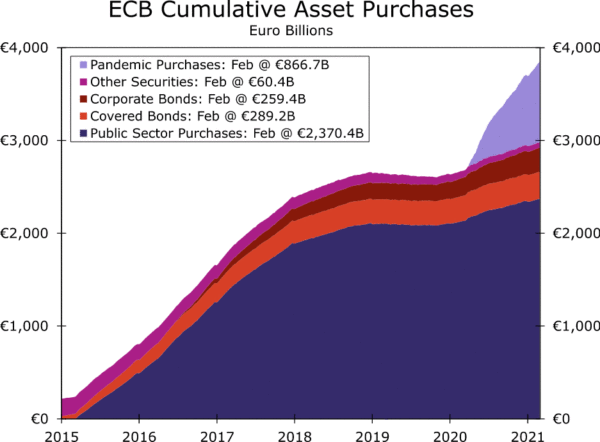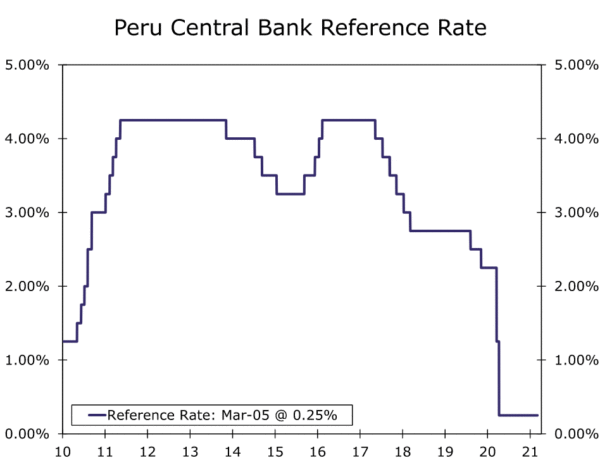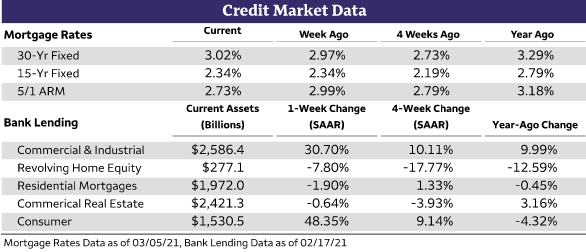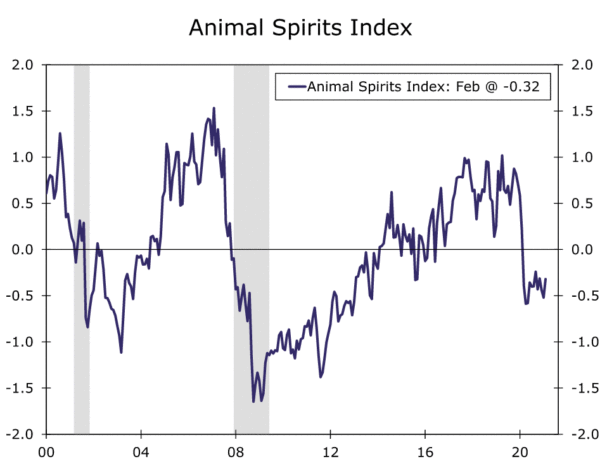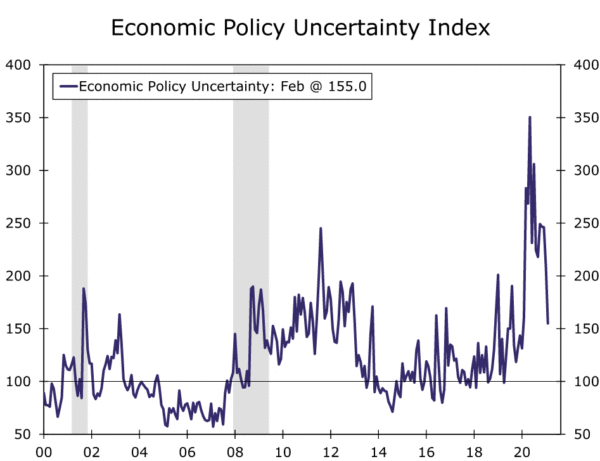U.S. Review
Moving On Up
- Most of this week’s economic data came in at or above expectations, contributing to growing anxiety about how the Fed will unwind the extraordinary stimulus it put in place.
- The ISM manufacturing survey rose 2.1 points to 60.8, with the new orders series jumping 3.7 points to 64.8 and the price paid series spiking to 86.0, which is the highest it has been since 2008.
- The ISM services survey came in below expectations, falling 3.4 points to a still perfectly sound 55.3. Both new orders and employment declined during the month, while order backlogs lengthened and the number of firms reporting paying higher prices for key inputs jumped 7.6 points to 71.8.
- Nonfarm employment rose by 379,000 in February, and the net revisions for the prior two months is 38,000 jobs to the plus-side. The unemployment rate fell 0.1 percentage points to 6.2%.
Global Review
Financial Markets Rattled and Warnings of Asset Bubbles; Eurozone Data Underwhelming
- Elevated government bond yields continued to disrupt global financial markets this week. Equity markets rolled over and foreign currencies came under pressure. Foreign central banks have recently become more vocal and active in their effort to contain bond yields.
- Contributing to the sell-off in financial markets was a warning from China’s financial regulator regarding prevalent asset bubbles. Chinese PMI data slipped again in February, as local lockdowns outside of Beijing remain in place. As of now, we do not see a major threat to China’s economy.
- Eurozone retail sales data missed consensus expectations by a wide margin. We can point to new COVID-related restrictions as rationale for weak data; however, softer data further complicates growth prospects in the Eurozone for the beginning of this year.
U.S. Review
Manufacturers Have Some Spring in Their Step
While the nonfarm employment data continued to be battered about by swings in leisure & hospitality payrolls, the goods portion of the economy appears to have strong momentum. The ISM manufacturing survey rose 2.1 points to 60.8, marking the ninth consecutive reading above the key 50 break-even level. The ISM is a measure of the breadth of the strength in manufacturing. February’s 60.8 reading is the highest we have seen in this recovery, which means that more manufacturers are seeing improving conditions today than at any other time since the economy was locked down last March and April. The production index rose 2.5 points, and the more leading new orders series climbed 3.7 points to 64.8.
Manufacturing should continue to gain momentum over the course of this year. Businesses are scrambling to rebuild severely depleted inventories. The customer inventories components fell 0.6 points to an extraordinarily low 32.5. The supplier deliveries index rose 3.8 points to an exceptionally high 72.0, reflecting strains in the supply chain. There is a severe shortage of truck drivers across the country, reflecting some changes in driver requirements. Equipment is also in short supply, especially around major ports. The revival in demand amid low inventories and what looks to be persistent supply-chain challenges is a big reason why the prices paid series has skyrocketed. We fear that these price pressures will prove to be more persistent this year.
Oil prices also rose to post-lockdown highs this week, with West Texas Intermediate crude quoted at around $65 a barrel this morning. The past week’s meeting of the world’s major oil producers resulted in no change to production, which should allow prices to firm a bit further. Inventories of crude are being drawn down, which should set the stage for production increases later this year. Rising gasoline prices should increasingly become apparent in the monthly inflation data.
Motor vehicle sales came in slightly below expectations, with sales falling to a 15.7 million-unit pace, which was down sharply from January’s 16.6 million-unit pace. Seasonal adjustment can be tricky at the start of the year. The light vehicle sales figures reflect manufacturers’ shipments to dealers. February’s harsh winter weather in Texas and parts of the South may have influenced the data. With more stimulus in the pipeline and employment set to ramp up, we expect motor vehicle sales to rev back up in coming months.
Source: Institute for Supply Management and Wells Fargo Securities
Private Sector Employment Bounces Back
Nonfarm employment rose more than expected in February, with payrolls rising by 379,000 jobs. Private payrolls rose by an even larger 465,000 jobs. January’s data were revised higher and now show a gain of 166,000 jobs, up from the previous reported 49,000-job gain. December’s data were revised lower, however. The net revisions for the prior two months is 38,000 jobs to the plus-side.
Job gains were fairly broad based. Manufacturers added 21,000 jobs in February, consistent with what was reported in the ISM data. Construction payrolls fell by 61,000 jobs and were possibly affected by the harsh winter weather that hit the middle part of the country in early February. While the power outages came a little later in the month, construction in Texas—which is the top state for home building—was likely held back somewhat. Employment in service-providing sectors jumped by 513,000 jobs, with the leisure & hospitality sector accounting for well over half that increase. New York, California and a handful of other large states that had been locked down much more than the rest of country are finally re-opening. State and local government payrolls declined by 83,000 jobs during the month, which likely reflects the still slow re-opening of public schools and universities.
The unemployment rate fell 0.1 percentage points to 6.2%, which was better than expected. The augmented unemployment rate also fell during the month. Aggregate hours worked fell 0.5%, however, reversing much of January’s increase. The harsh winter weather is likely behind that dip. We should see a rebound in March.
U.S. Outlook
NFIB Small Business Optimism • Tuesday
The NFIB Small Business Optimism Index started the year off on the wrong foot. The index declined 0.9 points to a reading of 95 in January, the third straight drop. The recent string of diminishing optimism is explained by the winter wave of COVID infections which led to a pullback in economic engagement toward the end of 2020. Small business owners tend to be more politically active, so unrest at the nation’s Capitol may have also played a role. Four out of the survey’s 10 components fell in January, and four others were unchanged. The share of small business owners expecting economic conditions to improve over the next six months fell seven percentage points to -23%, the lowest level since November 2013.
We do not forecast the NFIB on a month-to-month basis, but small business confidence will likely improve in the months ahead. The unusually harsh winter that significantly disrupted economic activity in Texas and other parts of the central U.S. could weigh on February’s results. That said, the number of new COVID cases and hospitalizations have been trending lower in recent weeks, while the pace of vaccinations continues to ramp up. Several states, such as California and New York, have recently announced plans to re-open parts of its economy, and Texas recently removed most restrictions on businesses. About 37% the NFIB survey are high-contact businesses such as full-service restaurants, retail shops, hair salons and dry cleaners, so the fall in COVID case counts and more relaxed restrictions stand to provide a boost to confidence.
- Previous: 95.0
- Consensus: 96.3
CPI • Wednesday
We expect market attention will be sharply focused on February’s reading of the Consumer Price Index (CPI) next week. During January, the headline CPI rose 0.3% during the month and 1.4% over the year. The monthly increase was flattered somewhat by rising energy prices, with gasoline prices jumping 7.4%. Goods prices edged up 0.1%, while the services index was flat for a second consecutive month. Elsewhere, inflation pressures remained fairly tame. The core index, which excludes volatile food and energy prices, was essentially unchanged in January.
We expect the headline CPI to advance 0.4% in February, a forecast that is in line with consensus estimates. Energy prices continue to rise, although it may take a month or two for the effects of February’s arctic blast that sent energy prices skyrocketing in many parts of the country to feed through to the overall index. Core prices are likely to pick up, but only modestly so. We look for a 0.2% rise in the core CPI. Bearing in mind that it typically takes several months for rising home prices to show up in the index, we anticipate another soft reading of shelter price inflation for February. Owners’ equivalent rent is the largest CPI component, which means tepid shelter price increases should continue to keep a lid on overall inflation for the time being.
Overall, core inflation is off to a slow start so far in 2021. That said, we expect price growth to pick up over the course of the year. Goods prices should continue to trend higher alongside rebounding commodity prices and supply chain constraints. Services inflation will likely turn higher over the course of the year as more of the services economy re-opens. Business and consumer inflation expectations have trended higher in recent months, which sets the stage for price increases as consumer spending ramps up this spring and summer. Even with a temporary burst of inflation over the next few months, we do not foresee a sustained break-out higher, which would force monetary policy to become less accommodative.
- Previous: 0.3%; Wells Fargo: 0.4%
- Consensus: 0.4%
International Review
International Bond Yields Continue to Push Higher
The theme that is still influencing global financial markets this week continues to be the rise in government bond yields. While the focus is still on U.S. Treasury yields, international sovereign bond yields continued to stay elevated. Higher global bonds yields have grabbed the attention of foreign central banks. Just this week, the ECB said it was “monitoring yields closely” and suggested a sustained rise in yields has the potential to disrupt the European economic recovery. German 10-year yields, typically a benchmark for European rates, have risen noticeably over the course of the year. While still negative, German 10-year yields have risen to -0.30% from -0.55%. Outside of Europe, the Reserve Bank of Australia (RBA) expanded its asset purchase program in an effort to contain bond yields. RBA policymakers also opted to purchase more bonds on the shorter end of the curve in an effort to defend its target rate on three-year bonds as well. The rise in yields has resulted in renewed volatility in international financial markets. International equities took another leg lower this week, while emerging market assets continue to come under pressure. Foreign currencies also depreciated over the course of the week as higher Treasury yields supported the U.S. dollar against G10 and emerging market currencies.
Also contributing to the sell-off in financial markets this week was a warning from China’s financial regulator that asset bubbles exist in global asset markets as well as in local property markets. China has given multiple warnings this year in regard to asset bubbles and has taken some action to prevent against over speculation in local financial markets. The immediate reaction to the warning was a drop in Chinese equities, which spread across international financial markets rather swiftly. In addition, Chinese manufacturing and non-manufacturing PMIs were released early in the week. PMI data softened again, although remain in expansion territory. We can attribute the decline in the PMIs to a renewed outbreak of COVID in small provinces outside of Beijing. As of now, we are not overly concerned that small lockdowns will disrupt China’s economy in 2021 and expect the economy to expand over 9% this year. To that point, the National People’s Congress (NPC) released their five-year plan this week with a target GDP growth rate of above 6% this year, a rather conservative goal. Included in the plan are intentions to support the economy through continued fiscal support; however, the NPC also stated the country will need to reduce leverage over time. A reduction in leverage could result in slower future growth rates as the economy has relied on borrowing to fund expansion plans for years.
Huge Miss for Eurozone Retail Sales
This week, January retail sales data were released for the Eurozone. The results were underwhelming on all fronts. On a year-over-year basis, Eurozone retail sales contracted 6.4% in January, a significant miss from the consensus forecast for a decline of 1.2%. On a month-over-month basis, data were just as bad. Retail sales contracted 5.9% month-over-month compared to estimates for a decline of just 1.4%. The underwhelming retail sales data were likely a product of renewed COVID-related restrictions imposed across the region in late 2020. Over the winter months, the Eurozone experienced a renewed upturn in COVID cases and put strict lockdowns in place through at least April. Lockdowns are clearly having a harsh impact on consumer spending patterns and will likely take a significant toll on Eurozone GDP in the early parts of 2021. In fact, retail sales data were so bad, we could possibly look to revise our Q1-2021 GDP forecast lower as a result. As of now, we forecast a modest economic decline in Q1; however, risks around that forecast are most certainly tilted to the downside following this week’s data release. With the Eurozone economy in the doldrums and external developments such as euro strength and the rise in global bond yields complicating the economic outlook, it is possible the European Central Bank (ECB) gets more active in attempting to spur economic activity. ECB policymakers have been slightly more vocal in recent weeks, and it would not be surprising if policy were to turn more accommodative in the near future in an effort to offset COVID-related restrictions.
International Outlook
Bank of Canada • Wednesday
Next week, the Bank of Canada (BoC) will meet to assess its monetary policy stance. In our view, it is unlikely Bank of Canada policymakers make any notable changes to monetary policy, especially as it relates to policy rates or asset purchases. We will be interested in hearing policymakers views on a stronger Canadian dollar, rising oil prices and the recent surge in global government bond yields. In the past few months, the Bank of Canada has mentioned a stronger currency could contribute to a slower economic recovery; however, with oil prices rising, perhaps the effect of a stronger currency will not be as important. In addition, we will be focused on whether BoC policymakers comment on how the rise in bond yields will affect the economic recovery and if Governor Macklem makes any attempt to talk down yields. Finally, BoC policymakers flirted with the idea of tapering asset purchases not long ago, as the Canadian economy showed signs of improvement. While we do not think bond purchases will be tapered next week, we will be curious to see if Governor Macklem suggests that quantitative easing could be scaled back in the near future.
- Previous: 0.25%; Wells Fargo: 0.25%
- Consensus: 0.25%
European Central Bank • Thursday
Over the past few weeks, European Central Bank (ECB) policymakers have been more vocal in regard to economic developments, both locally and globally. In recent weeks, ECB President Christine Lagarde has commented on the possibility of easier monetary policy, exchange rate developments as well as the sharp rise in global bond yields. In our view, the ECB will not make changes to monetary policy at this time; however, we do believe there is a possibility it could start to signal easier monetary policy is a real possibility. This week, retail sales data missed expectations by a wide margin as COVID-related restrictions affected consumer spending patterns. Softer-than-expected retail sales further complicates the economic outlook in the early parts of 2021. With economic activity under pressure as well as a stronger euro and higher bond yields to contend with, the Eurozone economic outlook could be deteriorating. In that sense, ECB policymakers may be forced to take action soon. At next week’s meeting, we will be focused on any signals from Christine Lagarde regarding plans to increase asset purchases or other targeted actions to spark economic activity across the region.
- Previous: -0.50%; Wells Fargo: -0.50%
- Consensus: -0.50%
Central Bank of Peru • Thursday
National lockdowns took a toll on economic activity in Peru and resulted in an 11% contraction in GDP last year. Peru’s economic contraction was the most significant decline within Latin America and one of the sharpest contractions within the emerging markets. With commodity prices rising, particularly copper, Peru’s economy could see some relief in 2021. However, we expect the Central Bank of Peru to keep policy rates at current levels for the time being, especially with CPI inflation at only 2.4% in February. In addition, we believe the local economy could experience renewed disruptions as it relates to presidential elections set to take place in April. Peruvian politics have deteriorated recently with multiple presidents either impeached or resigning over the past 12 months, sparking protests across Lima. Government officials seem worried too, as they recently tapped international capital markets for a $5 billion debt issuance in an effort to build asset buffers ahead of expected volatility tied to the election. With likely volatility ahead for Peru in the near future, we expect the central bank to keep policy as accommodative as possible at least through the end of 2021.
- Previous: 0.25%
- Consensus: 0.25%
Interest Rate Watch
No Major Changes Expected from the FOMC
The Federal Open Market Committee (FOMC) holds its next policy meeting on March 16-17. As is customary, the Federal Reserve published its so-called Beige Book this week ahead of that meeting. The Beige Book reports on conditions in individual Federal Reserve Districts and is among the materials that Fed policymakers use as they prepare for their meeting.
The current edition of the Beige Book reported that “economic activity expanded modestly from January to mid-February for most Federal Reserve Districts.” In addition, “employment levels rose over the reporting period, albeit slowly,” and “nonlabor input costs rose moderately.” Although some retailers and manufacturers were able to pass on the increase in costs to consumers via higher prices, many other firms were unable to so.
In short, the Beige Book gave no compelling reason to believe the FOMC will make any major policy changes, nor signal any imminent policy changes, at its upcoming meeting. The pace of economic growth at present was described as “modest,” payrolls are rising “slowly” and inflationary pressures appear to largely remain benign. These are not the words that normally would be used to describe an economy that was on the cusp ot overheating and was in desperate need of monetary restraint. Therefore, we look for the FOMC to maintain its 0.00% to 0.25% target range for the federal funds range and for it to continue its monthly purchase rate of $80 billion of Treasury securities and $40 billion of mortgage-backed securities. Moreover, we forecast that the Fed will continue its current rate of securities purchases through the end of this year, and that it will keep rates on hold through at least the end of 2022.
That said, the FOMC could make some technical tweaks to the interest rate it pays on the overnight excess reserves (IOER) that commercial banks hold at the Fed. The FOMC is also scheduled to release its quarterly macroeconomic forecasts at the conclusion of the meeting, which could make for some interesting reading. We discuss these issues in our “March Flashlight for the FOMC Blackout Period,” which we plan to publish early next week. This report will be available on our website.
Topic of the Week
How Are We Feeling?
The S&P 500 sold off 1.3% Thursday. A move like this seems to be rather pessimistic on its face, and, if continued, could certainly weigh on the confidence of consumers and business owners. Thursday’s move, however, was broadly understood to be the result of comments from Chair Powell that suggested the Fed is willing to tolerate the recent rise in long-term bond yields. While higher interest rates can certainly affect investors’ valuations of companies’ future cash flows, they can also reflect improving nominal growth expectations or economic optimism. Our Animal Spirits Index (ASI) attempts to parse through some of these conflicting signals by combining five indicators from different sectors in a dynamic factor model to provide a broader measure of economic sentiment.
In February, the index notched a solid gain, with all the underlying components improving on the month. February’s rise retraced the declines of the past two months, but the index remains below zero, which generally indicates pessimism. It is understandable that sentiment remains under pressure. There is still an ongoing pandemic and the economic recovery thus far has come in fits and starts. Looking forward, however, it is hard not to be optimistic about the economy, and this month’s broad-based improvement sets the stage for further ASI gains going forward.
Among the components, the Economic Policy Uncertainty Index continued to tumble in February, as single-party control in Washington and a clear focus on more COVID relief pushed the index to just below its year-ago level. The increasing likelihood of more federal stimulus alongside the jump in growth and inflation expectations helped push the 10-year Treasury yield up around 40 bps over the course of February. With the three-month Treasury yield parked near zero, the spread between the two has widened considerably. As noted above, rising yields have seemed to put pressure on stocks recently, but in February the S&P 500 rose 2.6%, more than making up for January’s pullback. Likewise, the VIX has picked up recently, but was lower on average in February and hasn’t touched 30 since coming off its late-January spike. These financial indicators have been the primary positive contributors over the past year, as markets have been able to look through some pandemic-related disruptions.
With the public health situation improving, however, consumers may be primed to drive the index going forward. Similar to the ASI, the Conference Board’s Consumer Confidence Index hasn’t been able to break out as spikes in COVID cases growth tempered any hopes of a return to normalcy. The index improved marginally in February, but the increasing pace of the vaccine rollout, coupled with more checks to households and momentum building in the labor market recovery, should provide the runway for further improvements in consumer sentiment. There are certainly risks that threaten this increasingly sanguine outlook, but if the economic recovery progresses in line with our forecast, we should see the ASI start to improve more consistently over the coming months.




